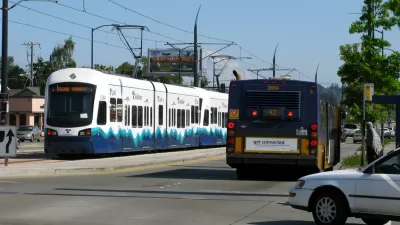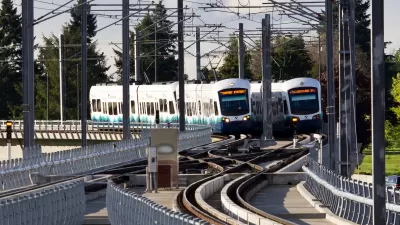Opponents of the ST3 transit funding measure in Seattle have argued that bus rapid transit is a cheaper alternative to light rail. A local write counter argues that point by making the economic case for light rail.

"A common criticism of the upcoming ST3 ballot measure is that light rail is too expensive and we’d be better off with bus rapid transit (BRT)," according to an article by Anton Babadjanov. In response to the argument for a less robust build-out of public transit infrastructure, Babadjanov examines the economics behind a range of proposed alternatives for addressing the congested state of roads around the region.
First, Babadjanov debunks the idea that wider highways would solve the Seattle region's traffic woes, based on concepts of induced demand and the massive size of the freeways that would be necessary to reach same level of lane-miles per capita as a city like Kansas City.
On the issue of buses, Babadjanov argues that for a bus to be an acceptable alternative to driving it needs to offer an alternative to traffic. Because long stretches of high-occupancy vehicle lanes are politically untenable, only new right-of-way remains as a path around congestion. But here's the rub: new right-of-way is actually the expensive part of constructing new light rail, and 80 percent of the cost for light rail in the ST3 proposal would go to right-of-way, according to Babadjanov.
So the argument goes: while Sound Transit is busy planning and building new right-of-way, it might as well make the most efficient use of it, with light rail instead of bus rapid transit.
FULL STORY: BRT Is Not Cheaper Than Light Rail

Study: Maui’s Plan to Convert Vacation Rentals to Long-Term Housing Could Cause Nearly $1 Billion Economic Loss
The plan would reduce visitor accommodation by 25,% resulting in 1,900 jobs lost.

North Texas Transit Leaders Tout Benefits of TOD for Growing Region
At a summit focused on transit-oriented development, policymakers discussed how North Texas’ expanded light rail system can serve as a tool for economic growth.

Why Should We Subsidize Public Transportation?
Many public transit agencies face financial stress due to rising costs, declining fare revenue, and declining subsidies. Transit advocates must provide a strong business case for increasing public transit funding.

How to Make US Trains Faster
Changes to boarding platforms and a switch to electric trains could improve U.S. passenger rail service without the added cost of high-speed rail.

Columbia’s Revitalized ‘Loop’ Is a Hub for Local Entrepreneurs
A focus on small businesses is helping a commercial corridor in Columbia, Missouri thrive.

Invasive Insect Threatens Minnesota’s Ash Forests
The Emerald Ash Borer is a rapidly spreading invasive pest threatening Minnesota’s ash trees, and homeowners are encouraged to plant diverse replacement species, avoid moving ash firewood, and monitor for signs of infestation.
Urban Design for Planners 1: Software Tools
This six-course series explores essential urban design concepts using open source software and equips planners with the tools they need to participate fully in the urban design process.
Planning for Universal Design
Learn the tools for implementing Universal Design in planning regulations.
Ascent Environmental
Borough of Carlisle
Institute for Housing and Urban Development Studies (IHS)
City of Grandview
Harvard GSD Executive Education
Toledo-Lucas County Plan Commissions
Salt Lake City
NYU Wagner Graduate School of Public Service





























